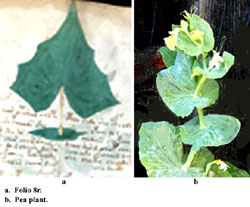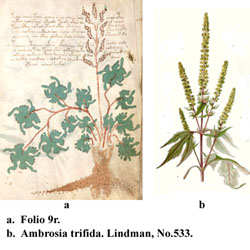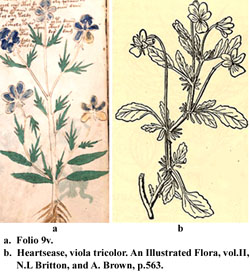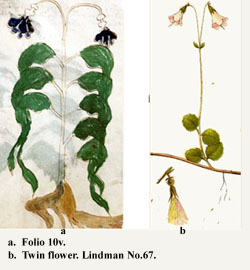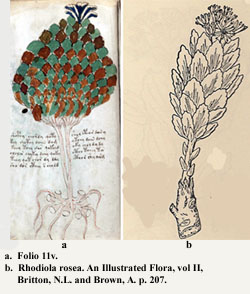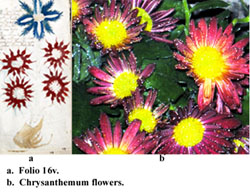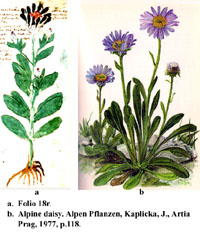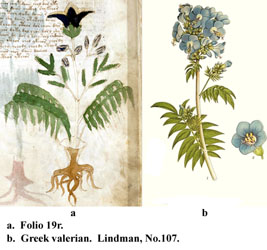The Voynich Botanical Plants
Folio 8r. Green Pea (Pisum sativum) is an annual Eurasian vine of the legume family that is grown for its protein-rich seeds. Cultivation of pea plants spread from the Middle East into Europe during Neolithic times. Mendel used green pea plants to establish his laws of inheritance and formulated the basic principles of modern genetics. (C)
Folio 9r. Ragweed (Ambrosia). The ancient Greeks considered that ragweed was food for the gods of Mount Olympus, hence the name Ambrosia. This weed is very difficult to eradicate and its pollen is a major cause of hay fever. (C)
Folio 9v. Heartsease / Wild Pansy (Viola tricolor). Heartsease has a long history of use as a herbal. It has been recommended for epilepsy, asthma, bronchial disorders and as a diuretic. As the name heartsease implies it was used as a love potion. Orphelia’s much quoted line from Hamlet: “There’s pansies for thoughts.” Shakespeare was referring to V, tricolor, and not a modern pansy. (1) (C)
Folio 10v. Twinflower (Linnaea borealis), is small alpine plant with a slender stems with opposite, evergreen oval leaves (plant 10v has very long leaves). The flowers are paired, pendulous, and pale pink with a five-lobed corolla. This was the favorite flower of Linnaeus. It was named after him and he took the flower as his personal symbol when he was raised to the Swedish nobility in 1757. (C)
Folio 11v. Rhodiola rosea. This is an alpine plant like many others in this section. The Russians and Scandinavians have used this plant for centuries to cope with the cold Siberian climate and stressful life. It may be effective for improving mood and alleviating depression. (1) (C)
Folio 13r. Banana (Musa). Linnaeus may have given the banana the botanical name Musa, after Antonius Musa, botanist and physician to the Roman Emperor Augusta, (c. 23 BC). Musa’s brother was Euphorbus, physician to King Juba II of Numidia, (ancient Libya), the plant Euphorbia was names after him. Pliny the elder noted that the people of India ate bananas. Arab traders introduced bananas into West Africa and Portuguese sailors started banana plantations in the Canary lslands. (1) (C)
Folio 13v. Honeysuckles / Woodbines (Lonicera periclymenum), The small Italian honeysuckle of Mid and Southern Europe is used as a skin tonic, and the seeds as a diuretic. Dioscorides wrote that a syrup made from the flowers is “good to be drunk against diseases of the lungs and spleen.” (1) (C)
Folio 16v. Chrysanthemum. This plant was first cultivated in China in the 15th century BC. The flowers were adopted by the 8th century AD Japanese Emperor for his official seal. The blue flower may be a stylized drawing of an Indian dendranthema. The small yellow or white variety of chrysanthemum is used to brew a sweet tea. The petals are used to thicken a snake meat soup. The seeds from pyrethrum, a species of chrysanthemum, provides a useful insecticide against all insects. (1) (C)
Folio 18r. Alpine daisy, Italian aster (Aster amellus). The name is derived from the Greek word meaning star. (C)
Folio 19r. Greek valerian (Polemonium caeruleum). Greek valerian is found in woodlands, meadows and rocky areas in temperate regions of Europe. It was first used as a medicinal herb in ancient Greece. The root was used to treat dysentery, toothaches and animal bites. In the 10th century it was used as an antiseptic and to treat rabies. (1) (C)
